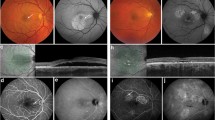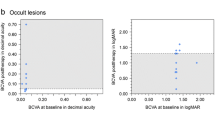Abstract
The evaluation of 430 consecutive eyes (87.5% from male, 12.5% from female patients) showed a leakage point with uniform dye spread in 93%. In 7%, a smoke- stack phenomenon was observed. The number of leakage points reached from 1 (71.6%) to 7 (0.2%). Most leakage points were found in a 1-mm-wide ring-shaped zone starting 0.5 mm from the center of the fovea. Beyond this zone the incidence dropped rapidly with the exception of the upper nasal quadrant. Of the leakage points, 33.2% were located in the upper nasal, 21.2% in the lower nasal, 19.0% in the upper temporal, and 14.8% in the lower temporal quadrant. Leakage points occurred more than 3 mm away from the center of the fovea in 11.8%. The papillomacular bundle contained 25.4% of the leakage points. Leakage points in recurrences were located within 1 mm of the primary leakage point in 80% of the cases.
Similar content being viewed by others
References
Bonamour G, Bonnet M, Grange JD, Pingault C, Heirieis M (1977) Topographische Studien über angiographisch beobachtete Läsionen bei Retinitis centralis serosa. Klin Monatsbl Augenheilkd 171:862–866
Gilbert CM, Owens SL, Smith PD, Fine SL (1984) Long term follow-up of central serous chorioretinopathy. Br J Ophthalmol 68:815–820
Hogan MJ, Wood I, Steinberg RH (1974) Cones of human retina: phagocytosis by pigment epithelium. Nature 252:305
Shimizu K, Tobari I (1971) Central serous retinopathy dynamics of subretinal fluid. Mod Probl Ophthalmol (Basel) 9:152–157
Spitznas M (1986) Pathogenesis of central serous retinopathy: a new working hypothesis. Graefe's Arch Clin Exp Ophthalmol 224:321–324
Spitznas M, Hogan MJ (1970) Outer segments of photoreceptors and the retinal pigment epithelium. Interrelationship in the human eye. Arch Ophthalmol 84:810–819
Wessing A (1967) Therapie der Retinitis centralis serosa mit Lichtkoagulation. Ber Dtsch Ophthalmol Ges 68:429–431
Wessing A (1973) Grundsätzliches zum diagnostischen Fortschritt durch die Fluoreszenzangiographie. Ber Dtsch Ophthalmol Ges 73:566–568
Young RW (1976) Visual cells and the concept of renewal. Invest Ophthalmol Vis Sci 15: 700–725
Author information
Authors and Affiliations
Rights and permissions
About this article
Cite this article
Spitznas, M., Huke, J. Number, shape, and topography of leakage points in acute type I central serous retinopathy. Graefe’s Arch Clin Exp Ophthalmol 225, 437–440 (1987). https://doi.org/10.1007/BF02334172
Received:
Accepted:
Issue Date:
DOI: https://doi.org/10.1007/BF02334172




